STUDIO



2022 - 2023
Design Studio by Asiya Sadiq Polack Project booklet by Alejandro Maturana | Levon Abrahamyan | Maide TaslidereKATHOLIEKE

Faculty of Architecture, campus Sint-Lucas, Brussels
2022 - 2023
Initiated by Ar. Asiya Sadiq with a colleague Martine De Maesener in 2013 at the Faculty of Architecture - KU Leuven, Campus Brussels, the Karachi studio has completed nine cycles. It was established with the intention of developing a specialized studio on Hyper Transforming Cities utilizing available in-house expertise, exposing our master’s students to the burgeoning urbanity in South Asia. The case of Megapolis Karachi introduces the participants to the local and global challenges faced by contemporary (in)Formal Cities in the making of their contemporary architecture, public and collective spaces, serving as a research-based design exploration for other similar situations in the global South.
-23
The unique design debate of Conditions vs Situations exploring the design potentials of the informal actors and processes which exist de-facto yet remain unrecognized in all our formal cities design protocols. Karachi and Pakistan serve as a case impacted by climate change requiring new ways of thinking, imagining, and making Architecture and Collective Spaces. Solutions need to be unveiled which can deal with the local as well as the global design challenges which concern contemporary hyper transforming cities like Karachi across the global North and South, in all their formal and informal complexities, emerging spatial trends and new social realities.
The topic of (In)formality in cities and the recognition of its impact on urban and architectural design as a Choice or a Need. The current formal – informal design norms, paradigms and parameters will be questioned, and new design ideas and strategies explored especially focusing on Climate Change while responding to the overarching debates of; neoliberalism, land scarcity and density, migrations, refugee influx, increasing urban populations, decreasing municipal resources, increasing disparities, impending pandemics and natural calamities like heat waves and floodings in hyper transforming cities like Karachi.
Aims of the 10th Karachi Studio – Fall Semester 2022This booklet is the result of a 12 week research and design process by a group of three students.
Alejandro Maturana Levon Abrahamyan Maide TaslidereDue to incapability of visiting Karachi, we have been researching the context from a distance. Due to lack of information on some topics, some of the research may be outdated and thus not correspond to reality.

Karachi is the largest city in Pakistan and the twelfth-largest city in the world. Karachi is Pakistan’s most reknown cosmopolitan city, linguistically, ethnically, and religiously diverse. It is aswell one of Pakistan’s most secular and socially liberal cities. With its location on the Arabian Sea, Karachi serves as a transport hub.

In 1947 the city experienced a dramatic shift in population and demography with the arrival of hundreds of thousands refugees from India.
This exponential growth in population resulted in nummerous economic, climatic and social issues. Moreover, Karachi faces a wide range of multi-factorial systemic issues that end up endangering the life of it citizens on a daily basis. Only issues related to our project are presented in this booklet.


-
Karachi is a culturally rich city that accepts everything and everyone, rapidly becoming the economical backbone of the country by the variety of both macro- and micro scaled private enterprises. Although it may sound very positive, the very fast-growing density and unbalanced organization between public and private sectors created a loss of cultural identity in the city, people sending money to the outsides of the city result in crumbling infrastructures directly impacting the quality of life of its citizens.
The lack of efficient urban programming throughout the years brought several systemic issues endangering Karachi’s population even more. The very extensive economical activity of 23 million people in Karachi, both formal as informal, creates a immense production of income but also uncontrolled production of disposable products. People need innovative and sustainable solutions.

Overall, climate change has caused a series of debilitating effects on the weather in Karachi, with a rise in average annual temperatures, increase in heat wave days, rise in sea levels, and a decrease in winter and summer rainfall in the arid plains and coastal areas.
According to a recent study by the Karachi Urban Lab, titled 'Designed to Fail? Heat Governance in Urban South Asia: The Case of Karachi', Karachi’s temperature has increased by 2°C - 4ºC at night and 1.6°C during the day over the last 60 years — an increase that is substantially higher than the global temperature change.
Given these alarming statistics, it is crucial to examine Karachi’s urban development discourse and future visions of smartness, especially in relation to heat. This, however is not the only problem. Next to the heat, the overall humidity is also stepping up, transforming the city of Karachi into a huge furnace.

In 2015, a very deadly heat wave took place in Karachi, killing about 1.300 people.
This loss of human life is not only a result of extreme temperatures of 45+ degrees, but rather a combination of different aspects like water shortage, electricity cutouts, heat island effect, poor soil permeability, etc.
Karachi’s rapid growth has heightened people’s exposure and vulnerability to heat. At least half of all Karachiites live in informal settlements, with little access to infrastructure and vital services.
However, in July 2015, Karachi experienced low air pressure phenomenon, which stopped the air circulation and led to extreme overheating of the densely built-up areas. Extreme heat lead to rapid drought of land, followed by heavy rains resulting in flooding because of poor absorption of water by the ground or drains.

-
When all the previous climatic factors are summed up, you run for cover.
Any form of shade or cover, whether they are trees or sheets tied overhead, it helps reduce the felt temperature by an average of 4°C to 5°C.
The problem is, it has become increasingly difficult to find cover in this concrete jungle. Karachi is hot, not only because of the aerial temperature, but also its humidity, exacerbating the felt temperature, making it even hotter.
The urban heat island effect, land surface temperature, air temperature, relative humidity and land cover with vegetation are the core factors that must be taken into account to ascertain the spatiotemporal patterns of urban heat islands. The complex interaction of global heating, urban warming and further use of heat-retaining materials in cities have made citizens’ lives difficult.
Officially, Karachi inhabits 16 million people, while the real numbers reach up to more than 23 million people. The population density varies from 1.000 and up to 3.600 people per square kilometer or around 2 people per square meter. With this population density, Karachi is facing various issues today. However, the density itself is not the main problem here.

As mentionned above the official and unofficial numbers of population vary drastically, and more than 7million people apparently do not exist according to the government.
Although these people may be considered illegal or irregular in some situation, informal citizens represent 56% of the National Gross Domestic Product.
Karachi is responsable for 25% of Pakistan national GDP 70% of the National Income Tax Revenue 95% of the International Trade 30% of Large Scale Manufacturing
Inside the formal percentage, Karachi’s informal economy is 56% of the 25% of national GDP percentage


40% of the 70% of National Income Tax Revenue 53% of the 95% of international trade
17% of the 30% large scale manufacturing

Flooding is a global phenomenon which causes widespread devastation, economic damages and loss of human lives.
In Pakistan, it is the single most damaging natural hazard, with 21 major floods having ravaged the country between 1950 and 2010. According to an Asian Development Bank report, around 8.887 fatalities were reported in this period. Financial losses were up to $19 billion (2010).
The 2010 mega flood impacted the lives of nearly 20 million people, or 10 per cent of the country’s population. This mega flood alone is estimated to have caused losses worth $10 billion (or 5.7% of that year’s Gross Domestic Product) in lost productivity due to damages to infrastructure, agriculture and ecosystem services. During the following five years, a major flood event occurred at least once each year, affecting millions more. During this summer of 2022, a new flood hit Pakistan, killing thousands and obligating millions to migrate from their livelihood to survive.
We observed different types of floods in Pakistan, such as coastal floods due to the uprising of sealevel or continental floods, occuring because of heavy rains due to fast evaporation of continental waters. These are caused by the very poor infiltration of water into the earth, heat enhances the phenomenon of evaporation and poor soil permeability. Finally, flash floods, occuring because of continental flood together with heavy rains, if the urban fabric can’t handle the amount of water coming downstream, flash floods will occur, endangering the lives of everyone staying in its way.

Since 2010, floods have become the most impactfull climatic phenomenon. We observe that since this same year, floods have become a systemic issue repeating every year, being the source of many problems for the citizens of Karachi. Most of the people affected are economically vulnerable and as Karachi thrives by its informal communities, the impact on the city is very neat.



33 million people have been displaced due to the flood this summer. We observe a yearly movement of people leaving the city to come back as it is economically attractive and rentable to live and work in Karachi.
We found out that these migrating group are called Internally Displaced Persons (IDP)

During the flashfloods, the most impacted parts of the city are the nalas, as these nalas are the principal stream for water evacuation. These nalas used to be natural drains that brought the continental water downstream to the rivers and later on to the Arabian Sea.
We will focus on flashfloods in this project, as we see the potential to design a project that could fit the need of informal communities to be resilient against floods and rise awareness on how exposed they are to floods.

We observe from this table, that what used to be natural drains became nalas, responsable for the sewage and drainage of water. A lot of waste ends up in this nalas, perpetuating the problem of backlog and encroachment. From previous research, we conclude that the mapping of nalas became a very important tool to understand the situation of water management in Karachi.

During the research, we came across the common belief or myth that mass-migration would be at the core of the pollution of the nala’s. These is taken as an empirical fact, as before 1900, Nala’s were used as stormwater drainage and split sewages where black water was treated to grow vegetation. After the independence in 1947, a mass-migration took place, attracting more than 800.000 people from India and Afghanistan to Pakistan. People were attracted by the ecnonomical hub that Karachi became and for most of the people migrating, Karachi was the place to be.


This mass-migration put the social fabric under pressure all throughout Pakistan, and made Karachi enter the list of Hypertransforming cities. After The year 2000, following various economic, diplomatic and climatic issues, a new group called IDP’s or Internally Displaced Persons are constantly on movement, few migrate but come back to Karachi a soon as they can afford it.

Inside the group called IDP’s, millions of people come back to Karachi to find the livelihood they seek for, the most vulnerable between them have no other choice than seek for vacant plots to live or build on.
Although most of them do have good proffesional lives, most are still living in informally constructed buildings in area’s where housing is illegal.


Inside the group called IDP’s, we find people living in vulnerable conditions, most of the people impacted by the floods are uninformed communities and citizens. Unaware of the danger and/or the impact that the flood could possibly have, vulnerable dwellers migrate from which they loose their life investments, and because of the abscence of help, the more vulnerable citizens end up losing their life.
Before the last flood occured on August of 2022, there had been 29 neglected flooding reports in 1 month. The floods is responsible for 8 burst dams, severe damage to bussinesses and bank headquarters.
Water raised 126 cm high in 3 hours, dragging everything with it for more than 10km, forcing people to flee or stay, with all the consequences attached to it.
Foreign Minister of Pakistan Bilawal Bhutto Zardari
The Government is aware of the issue and are concerned about the lives beeing taken from these climatic phenomenons such as floods and thrive to tackle these issues for more than a decade now.
In an interview with Foreign Minister of Pakistan Bilawal Bhutto Zardari, he empathetically shared his concerns and advices, but all throughout the interview, the foreign minister is consistently pointing finger to the rest of the world. We could frame his position in his conclusive sentence were he said ;


‘... the citizens of Pakistan are paying the price with their lives for the industrialization of the rest of the world that has resulted in this climate change.”
“We consistently see climate devastation in the forms of floods, monsoons, extensive droughts, extreme heat waves,... And frankly, the citizens of Pakistan are paying the price with their lives for the industrialization of the rest of the world that has resulted in this climate change.”
We do conclude from his positioning, that the government is NOT responsible for the damage caused by climate change and therefore, only focus on the impact rather than the causes of floods. This argumentation is also based on the following facts:
Although Pakistan is 31st in the list of worldwide CO² emissions by country, being responsible for only 0.5% of the global CO² emissions, Pakistan is ranked 8th and going this year to the 5ft position of countries affected by climate-change related phenomenons.

This duality brings the government to a serious reality, the fact that they cannot change the way they affect climate change, but only change the way they protect themselves against these climate-change related phenomenons.


The governmental narrative is to engage into a Urban master plan of widening the nalas, in order to erase the nala encroachment from solid waste and be able to absorb the amount of water streaming down in case of flood.
 Gujjar nala
Manzoor nala
Lyari river
Malir river
Orangi nala
Gujjar nala
Manzoor nala
Lyari river
Malir river
Orangi nala



Gujjar nala Manzoor nala
Gujjar nala Manzoor nala
• Solution •
Erase encroachment in and along the nalas.
Orangi nala
Orangi nala
In August 27 of 2019, the record-breaking rainfall which led to unprecedented urban flooding and a near-collapse of its infrastructure. Subsequently, the Supreme Court of Pakistan issued a judgement directing the Sindh Government and the NDMA to clean up Karachi’s major stormwater drains. Then, in February 2020, the government of Sindh initiated a large-scale anti-encroachment operation along the Gujjar and Orangi Nalas, in accordance with the Supreme Court order of August 2020. The anti-encroachment operation was based on a Global Navigation Satellite System Survey that identified structures required for demolition by flying a drone over areas impacted. Then, these structures were assigned unique ID numbers and percentages that delineated how much area was required for demolition. The ensuing anti-encroachment operation saw the large-scale displacement of residents and the demolition of thousands of homes across low-income housing settlements in Karachi.



Erase encroachment in and along the
- Solution of Nala widening2.7 billion PKR.s (115 million €) > 150000 m² demolished > 5.000 homes > 50.000 people evicted > 16.000 households

We made a general section of the morphology of the nalas before the widening, we can observe very narrow ‘sidewalks’ on which children play, adults rest and communities gather.
The dumping of waste and the sewage end up in the nala, people living beside it make difficult the cleaning of the nala and lack of ecological awareness makes people ignore the well-being of the nala.

We also made a general section of the morphology of nalas after the widening, we can observe the added space around the nala, after the demolishions and/or evictions.

We can also conclude that nala will be wider, but not higher, what could cause overflowing in times of flood.

The issues of solid waste is also not taken into account, therefore perpetuate the dynamic of dumping waste into the nala, as Karachi lack solid waste management infrastructures.
Solid waste backlog issue not included in the governmental project
The Karachi Bachao Tehreek undertook a research and data collection initiative to challenge the premise of the anti-encroachment operation and explore its consequences in material and social costs to the affectees. This was a collaborative effort between activists, trained researchers working on the issue, and residents of the communities who had in-depth knowledge of the areas affected.

- No resettlement and rehabilitation.
- No site designated to relocate.
In a city where a majority of the population does not have access to affordable housing, rendering people homeless without adequate compensation will marginalize them further. Moreover, the amount fixed as compensation is based on the assumption that affectees have the financial means to relocate themselves. A uniform compensation amount also does not take into account the varying needs of multiple members of the households based on age, gender, dis/ability, health conditions, etc.
- No resettlement and rehabilitation.
Based on our survey, an estimated 12.789 women and 20.980 children will be affected, along with 2.058 elderly people above the age of 65.
- No site designated to relocate.
arrange alternative housing from themselves. endanger livelihood, safety and social relations.
There are no municipal plans for resettlement and rehabilitation. The government has not designated any sites for affectees to relocate.
In paying residents a fixed amount for rent for two years, the government assumes that residents will be able to arrange alternative housing for themselves. The cost of acquiring land and constructing a house has not been accounted for within the compensation package.
https://karachibachaotehreek.org/
Residents should arrange alternative housing from themselves.
Housing demolition endanger livelihood, safety and social relations.





https://karachibachaotehreek.org/

From previous research and findings, we conclude that there is not only one truth or perspective in this topic.
We understand the interests at stake in both narratives and commit to design a new way of collaboration that will not only respect but also benefit these interests on the shortand the long-term.
We take position as mediators and technical assistance for the citizens of the Gujjar Nala, personally engaging into understanding the different narratives and create a new one.
This new narrative consists in showing by design the advantages of collaboration between scientific entities, governmental bodies, NGO's, technicians, activists and informal communities in order to create a project that could translate the multifactorial situation into architecture that provides a middleground solution to the different narratives.


Gujjar nala is a stream of 27 km long passing through Karachi, giving space to twenty eight settlements or colonies.
We are going to focus on Gujjar Nala because most of the problematic demolitions have taken place on this nala. We could find both official as unofficial sources of information from wich we could imagine the complexity of the framework we wanted to work in. The Gujjar Nala showed the perfect set of issues and potentials that inspired us towards our final poject.
As the operation of widening began recently, we took this as an opportunity to conceptualize and work out a project that would adapt to the current works.
We analyzed the Gujjar Nala, but keeping in mind that the problems we had mapped during the research, are not intrinsically related to the site, but to a larger spectrum of issues. Therefore, we chose to design a project in which both global and local scale could be matched, showing the potencials of local solution to global problems.

We observe solid waste building up under bridges, this encroaches the stream and creates backlog from the drainage.

Gujjar nala is infected and can lead to a variety of health related issues, from which many families have to spend high medical cost related to infections or other diseases passed on by mosquitos.

Lack of soil permeability is enhanced by the building density of the site , very few public spaces are available and do not have nature.

We conclude on a lack of shade and qualitative public spaces all along Gujjar nala. Poor vegetation creates the ideal ecosystem for heat island effect.

Infrastructure Mismanagement
Sewage Solid Waste Uncontrolled Housing Relocation
Urban Floods
Migration of the informal communities

Heat radiation
We observed and explained the loop linking both narratives, we mapped the correlations between the following main issues, being sewage, solid waste and uncontrolled housing. These actually enhance the impact of the yearly floods systematically closing the loop of problems for both the government and the vulnerable people living along the nala’s.

Low income people displaced
Chemical/bio-waste into nala
Heavier rainfalls
Damaged buildings
Waste/Diseases spreading
Inability for greenery
Chemical/bio-waste into nala
Poor infiltration
Waste backlog


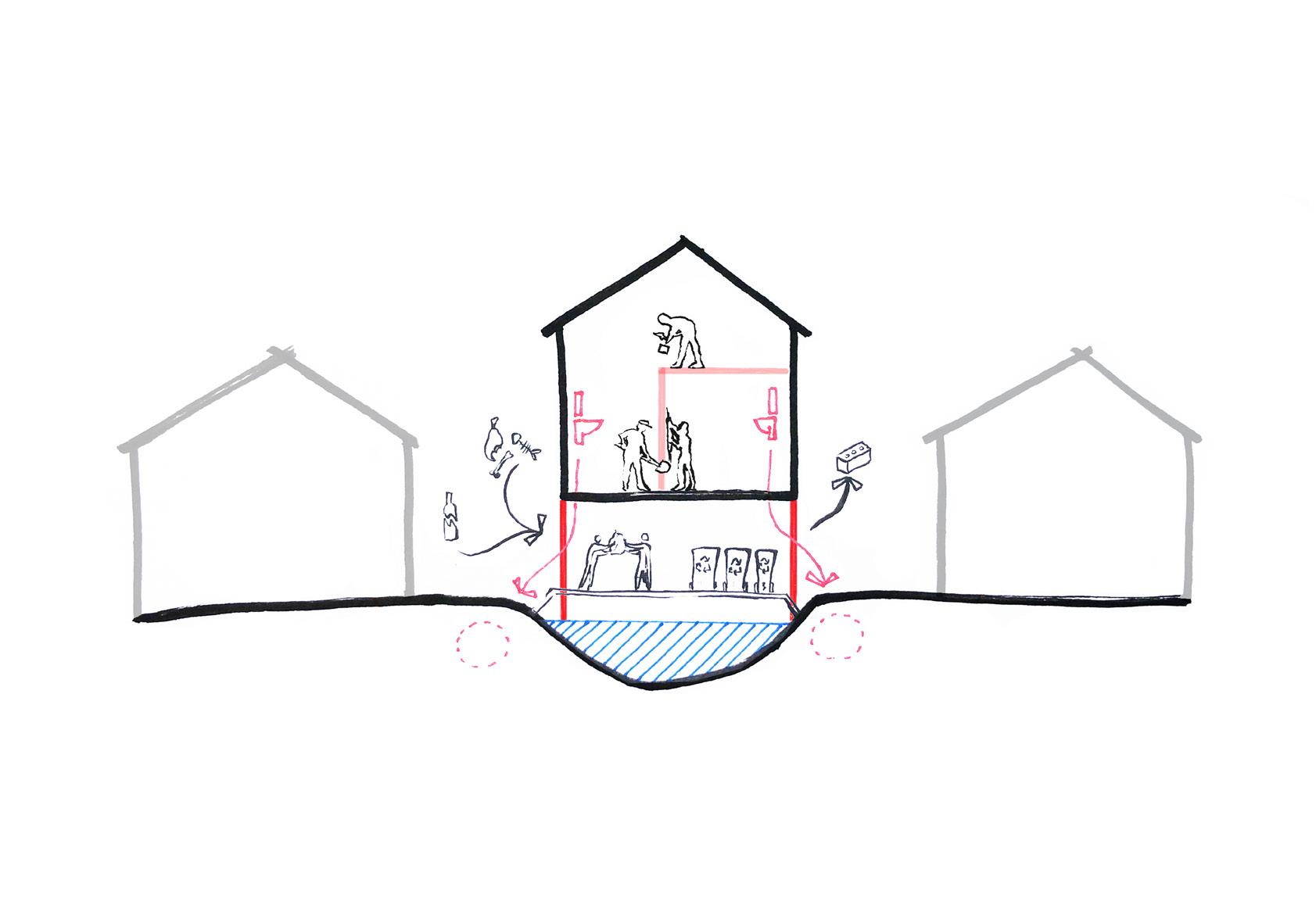
- Reviving the nalas through community-led management of housing, sewage and solid waste -

- To enhance ecological awareness and resilience of informal residents -

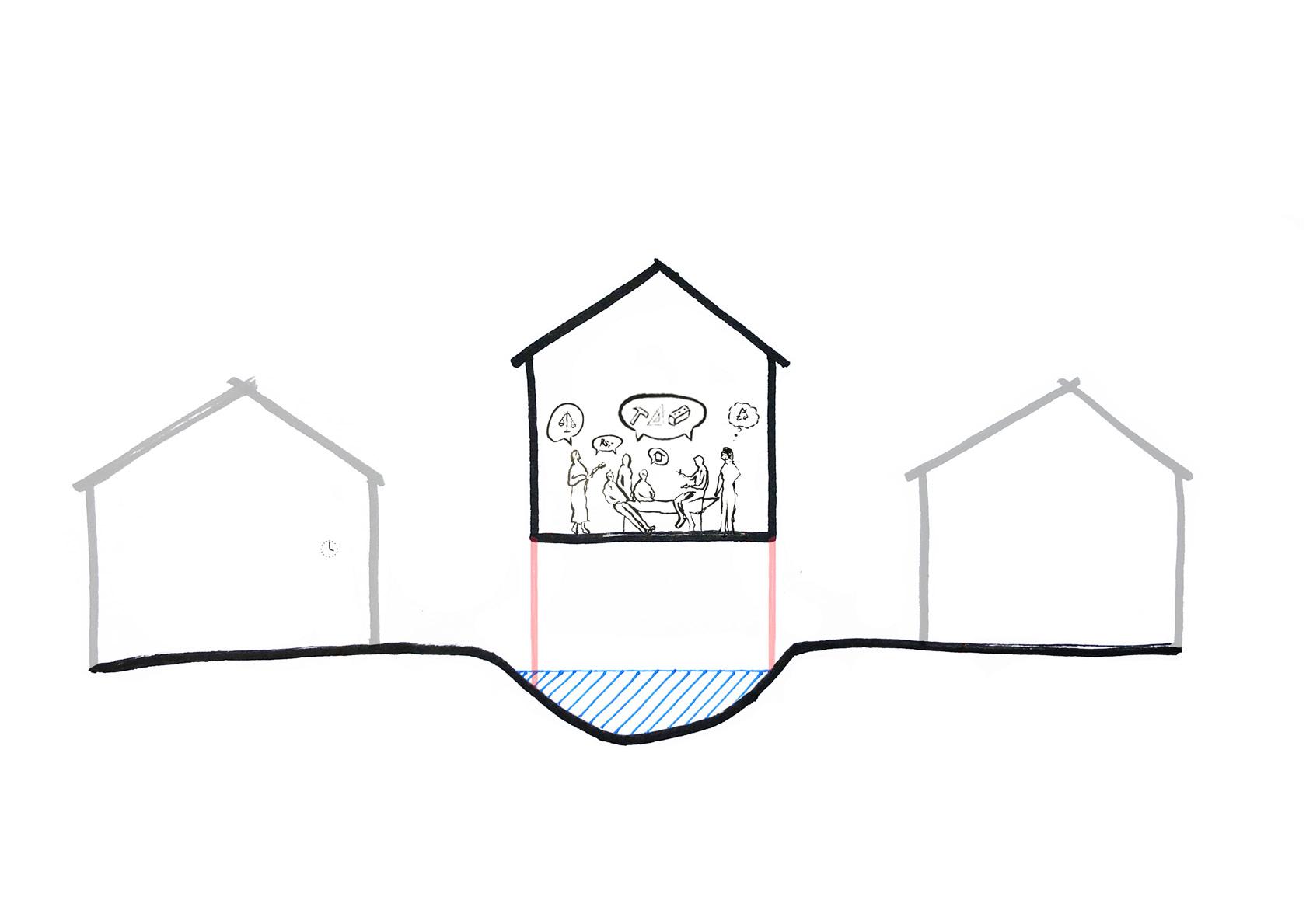

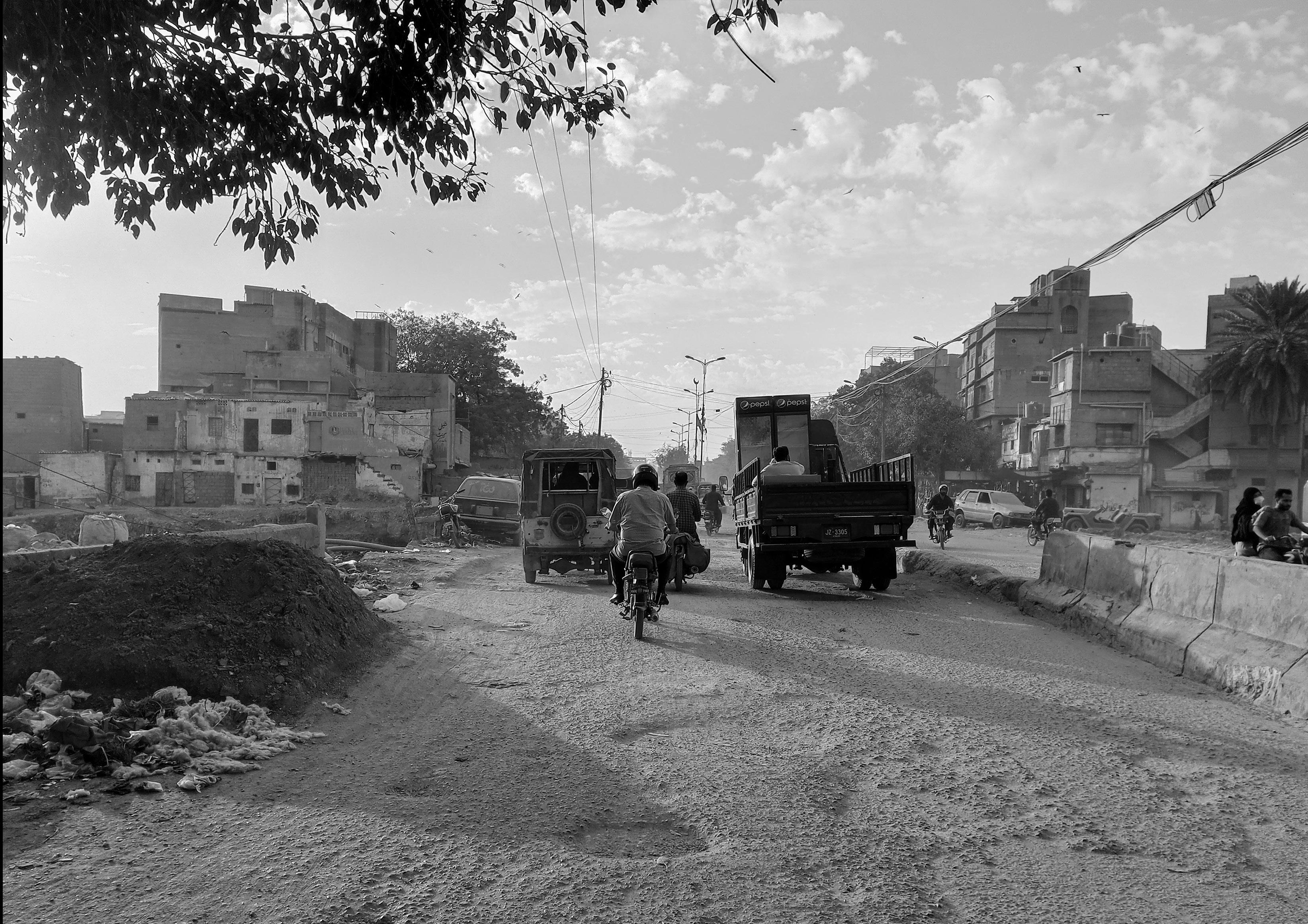
We chose this specific site for it’s morphology, we could encounter different turns and architecture adapting to the site. This site was a condensed sum up of all the difficult morphologies we could find on the Gujjar nala.
574m long stroke between formal bridges. 8.100m² demolished 1.306 people evicted


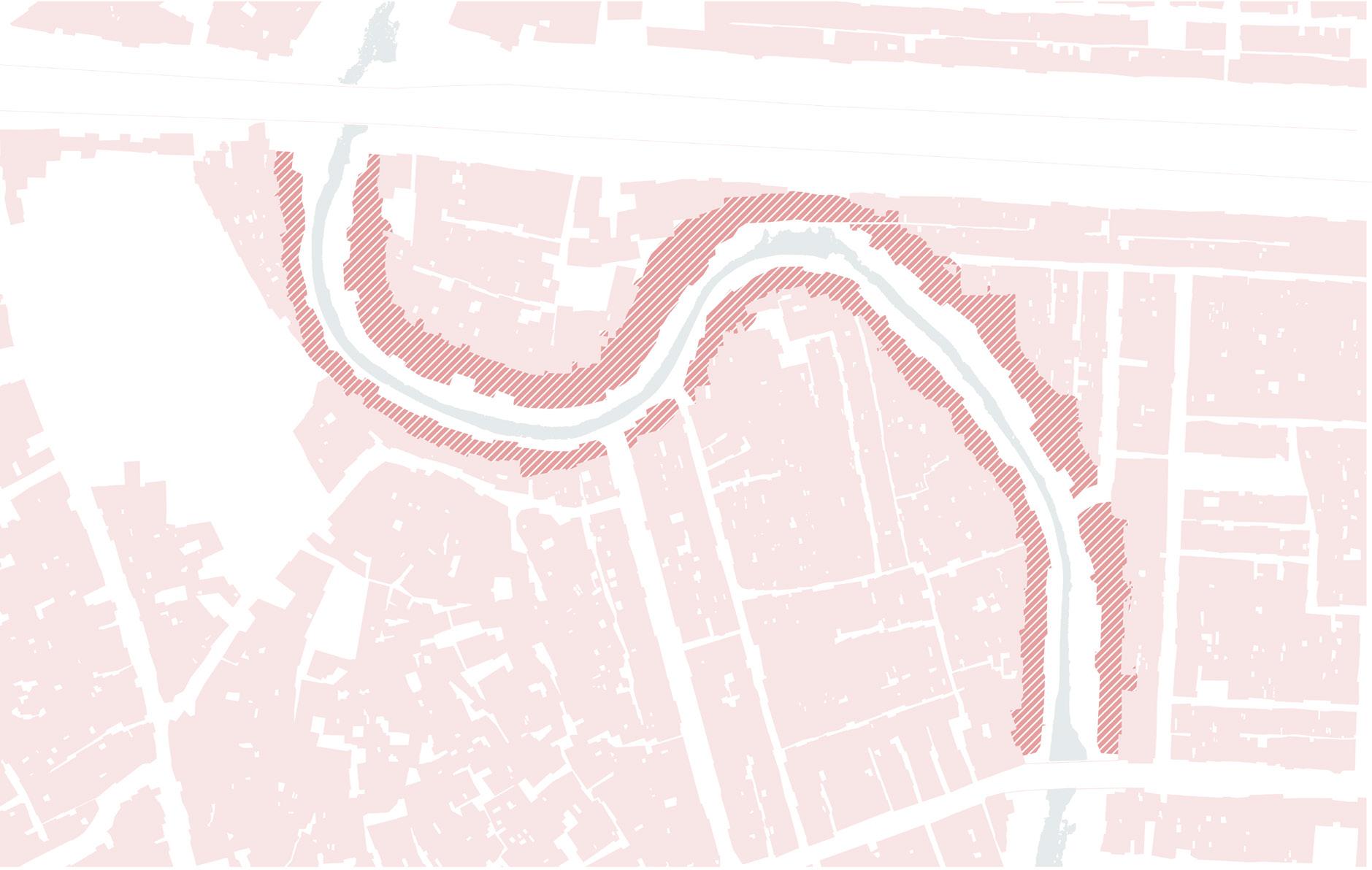
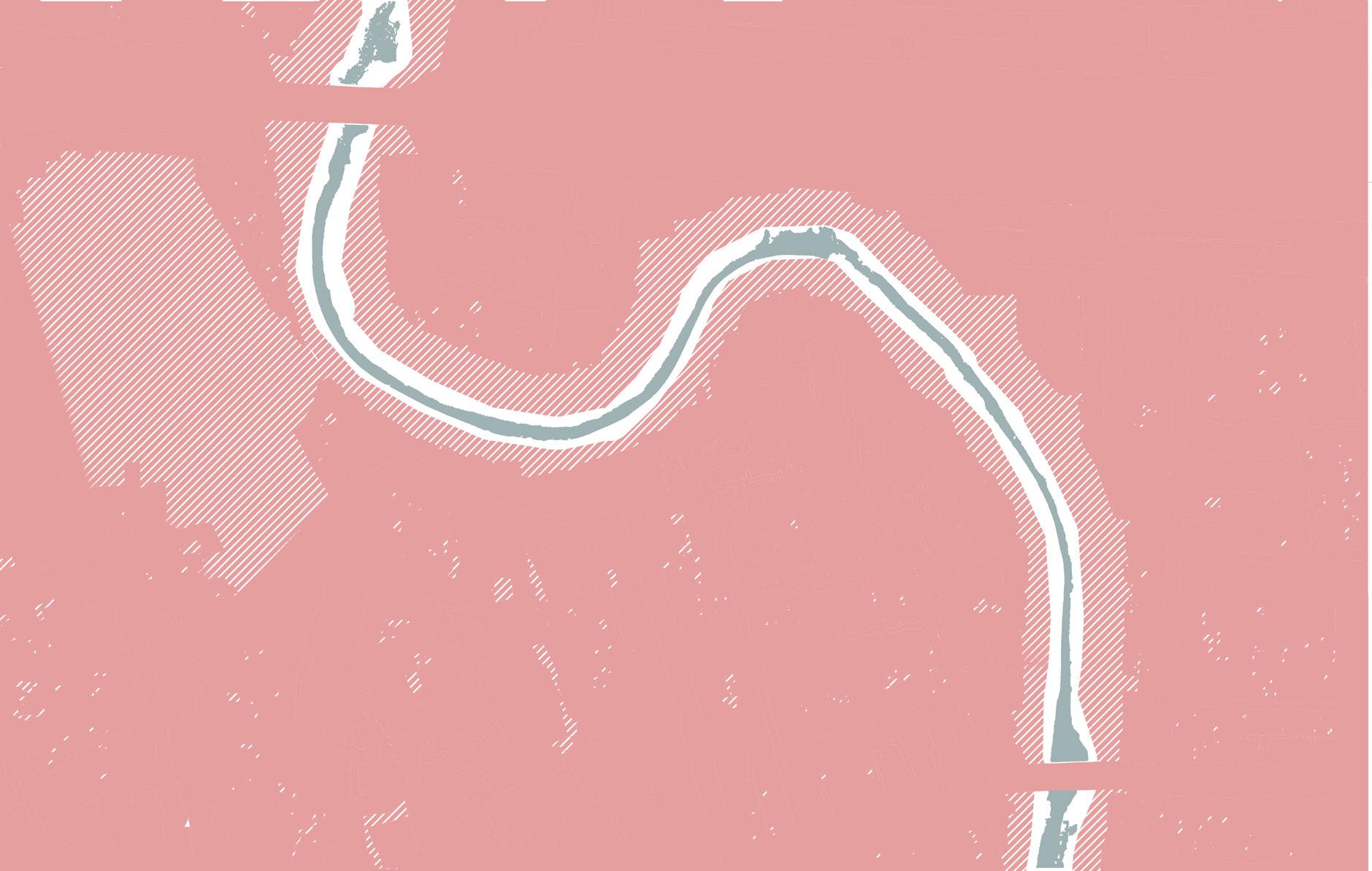
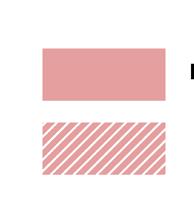

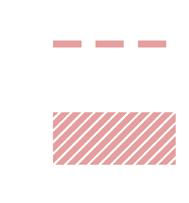
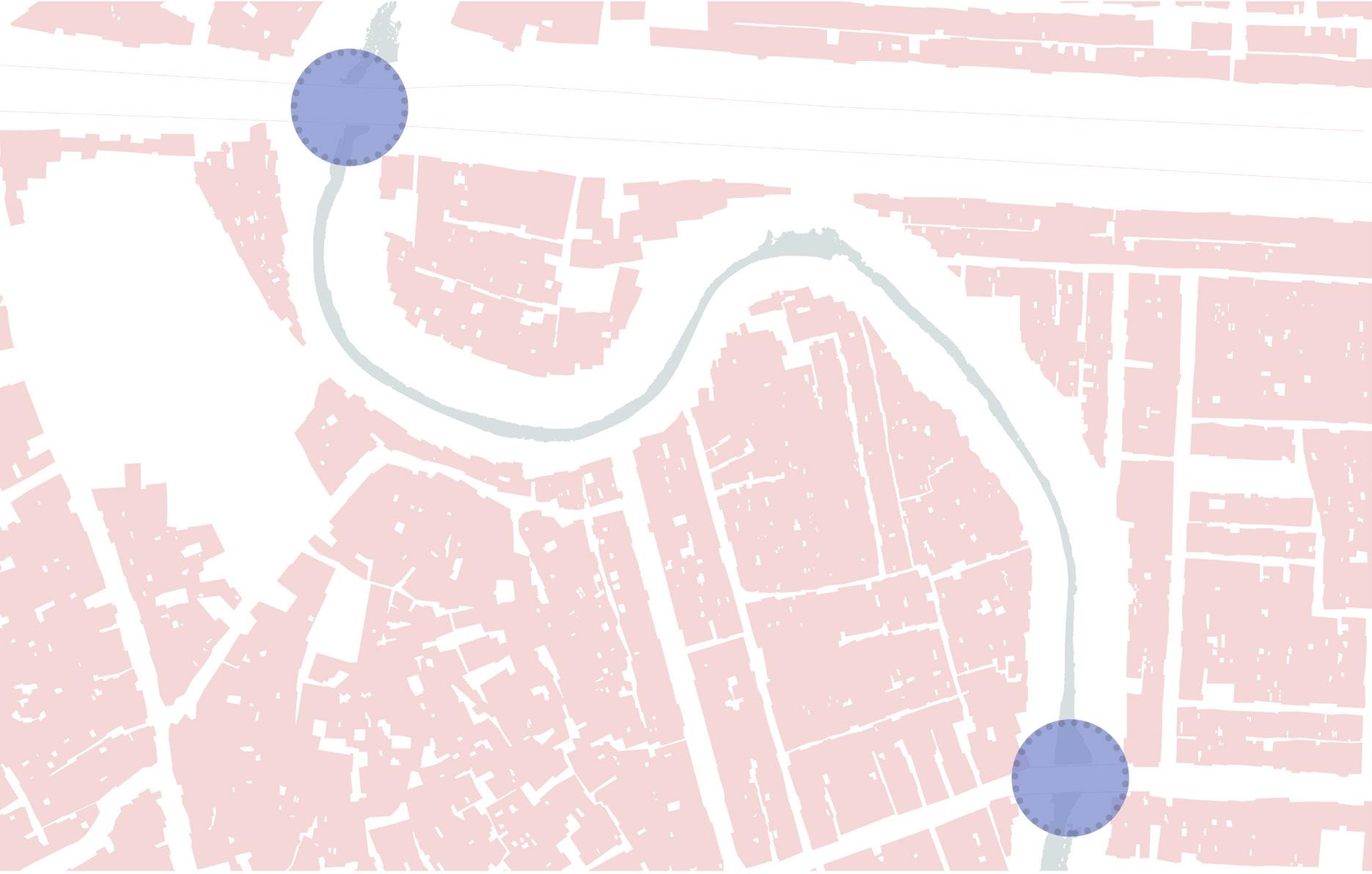
Pedestrian
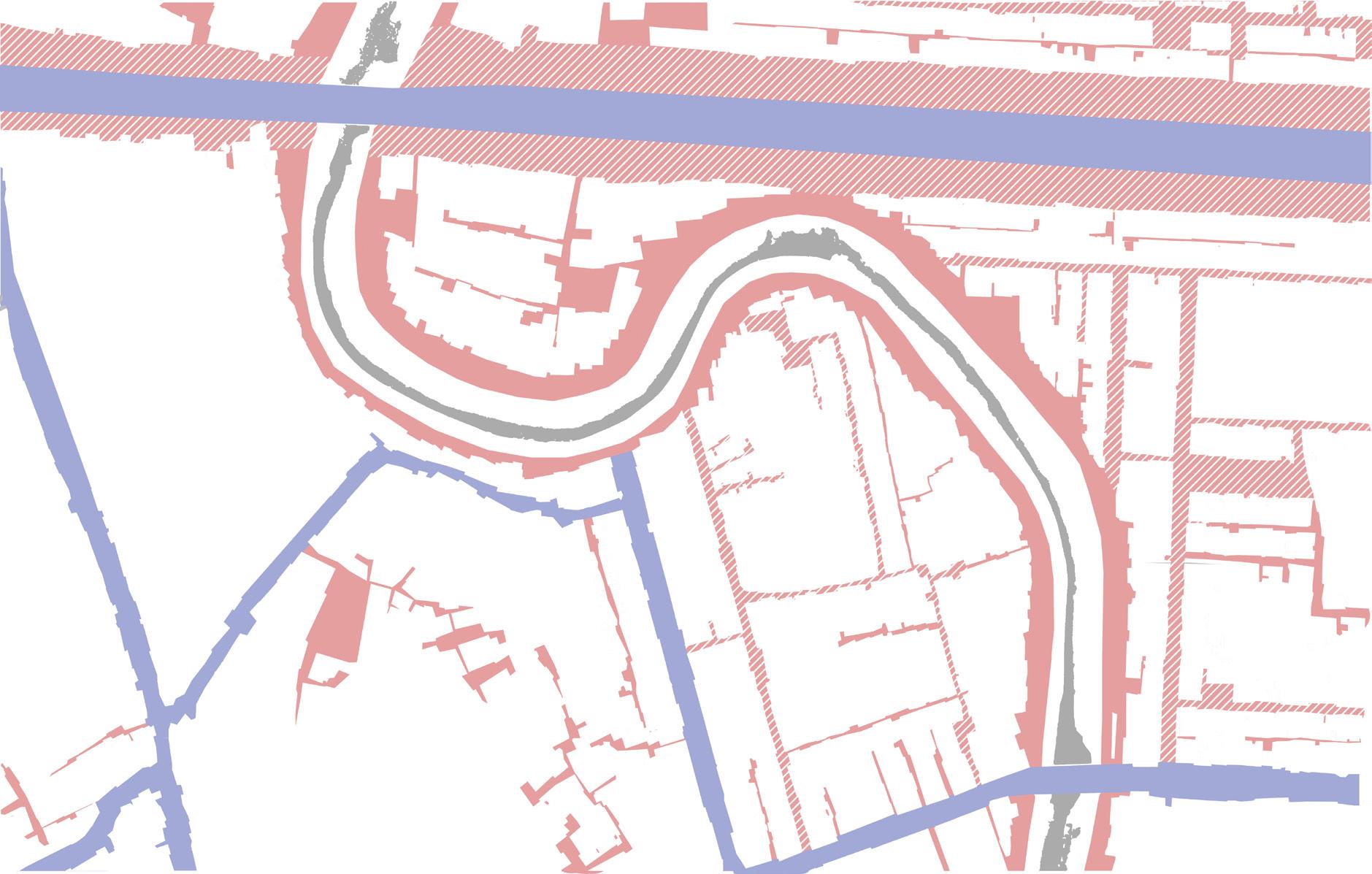
Mainly pedestrian
Vehicular





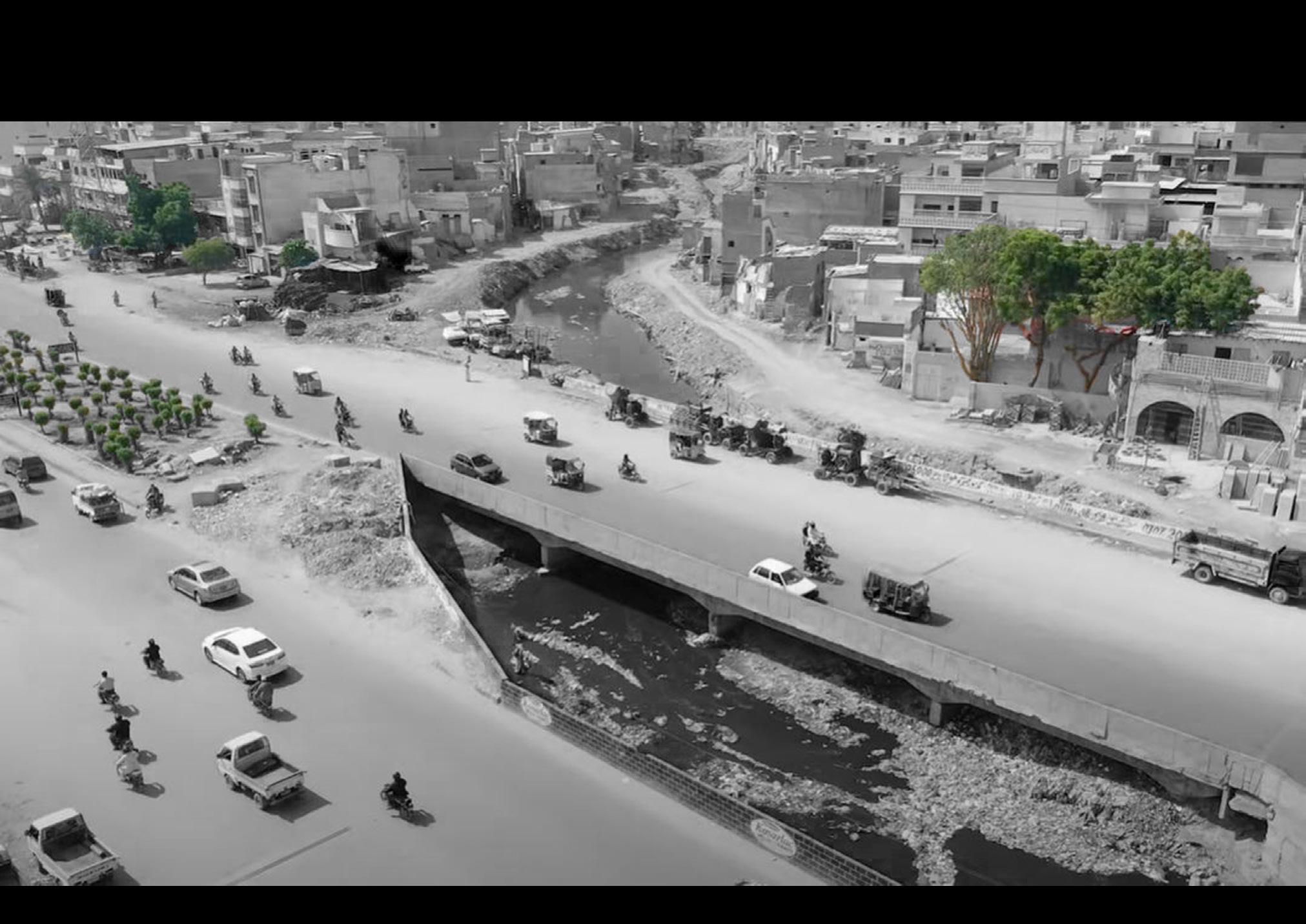
- MEN -


We have been able to gather information about various communities living beside the Gujjar nala but didn’t manage to find all the information we needed to construct a respresentative image of the site. We have found some information on evicted dwellers and what were their endeavours before their eviction.
We have projected this data onto the site we had chosen for the
Akbar has been working as a shoe sorter in Wahid Colony for the past decade. They come from big countries and are set into different categories. The ones in almost perfect conditions are sent to countries like Indonesia, Malaysia… all parts of Asia. The second quality is sold here in the markets near lighthouse and Sunday Bazaar.
Younus works as a recycler and has lived in Moosa Colony for the past 45 years. Today, he risks to loose his life investment as the land he used to work on will be declared unbuildable.
Majed owns an embroidery workshop in Moosa Colony and employs eight people, he doesn’t live on the zone of demolishion, but his store, that makes him earn a living will be demolished, leaving him and his eight co-workers lose their job.


Most of the households on Gujjar nala have no women working as they are mostly home during the day and involved in daily shores, one of the most important one would be purchasing or gathering drinkable water. In this area, women don’t go out unless for work or a specific reason.


Most of the working women are responsible of small shops and giving services like workshops, classes on different topics. They also rent spaces to take care of other children and other small endeavours. They charge about PKRs 10 for a football game where kids just come and hang out with their friends.

Ayesha owns a small shop in the border of Mujahid Colony. Most of the women work as maids and they come back in the evening, make dinner and don’t really have enough time to hang out outside.
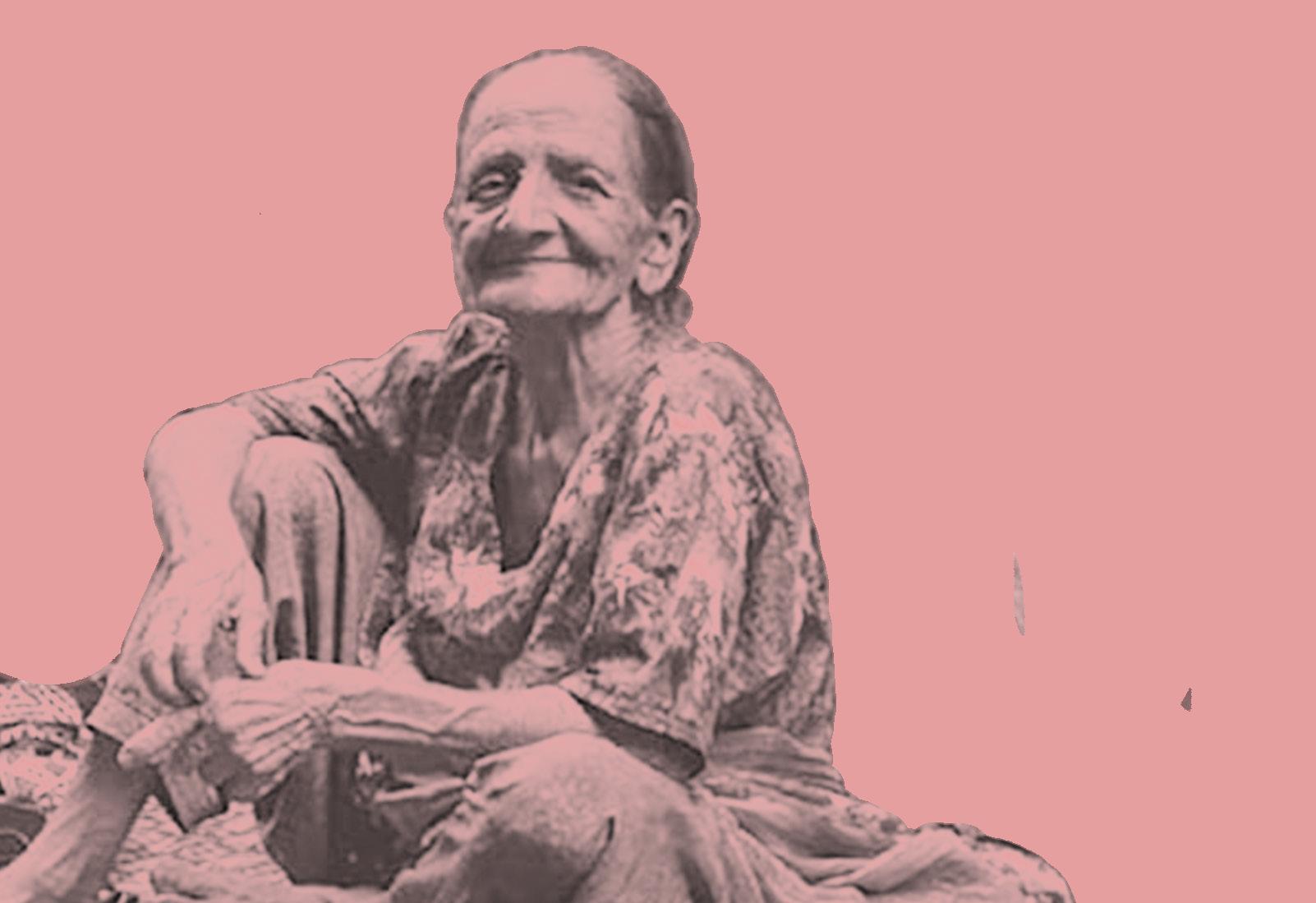
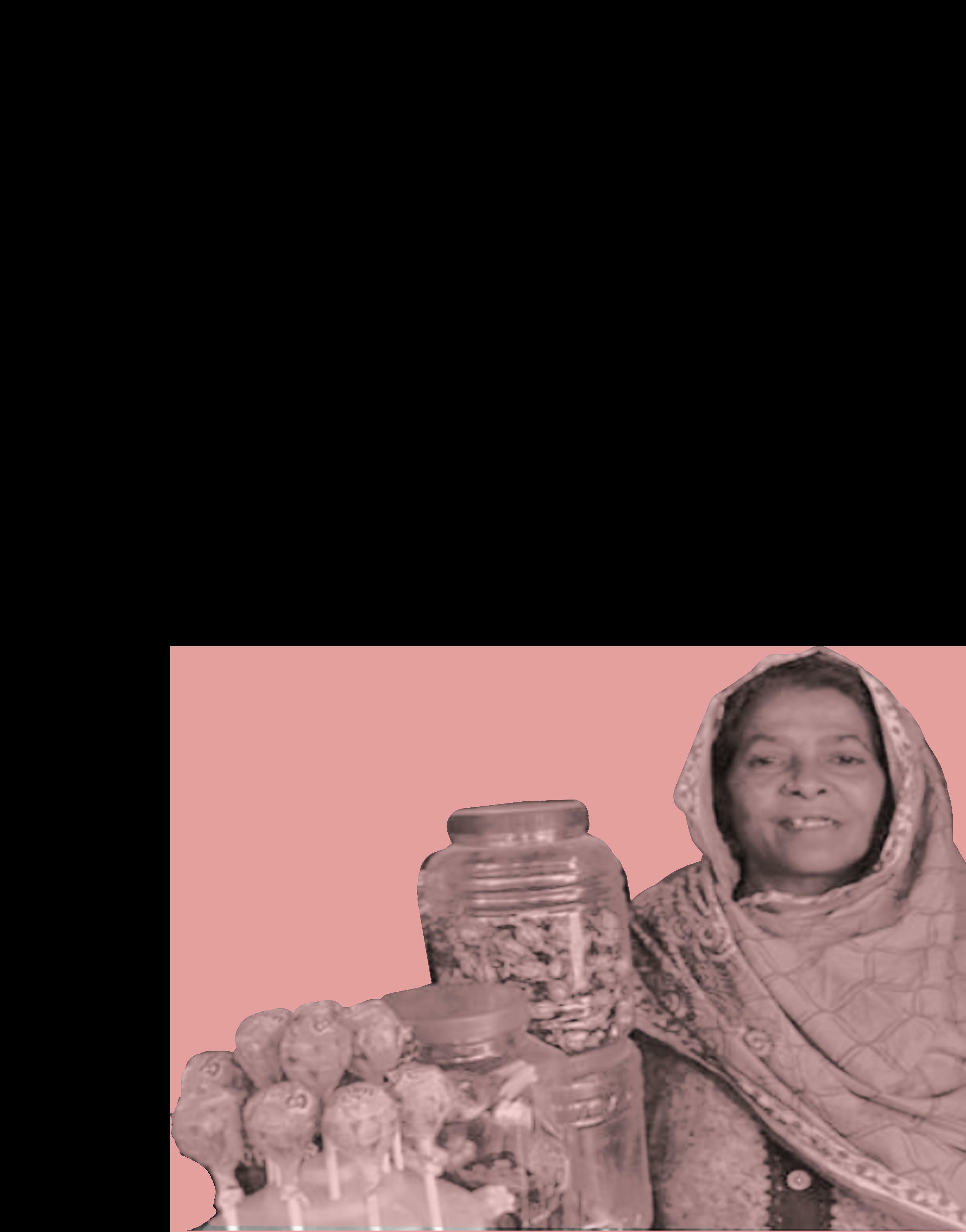



We have had a difficult time mapping the different activities of children in Gujjar Nala. Children have basically two options of activities, work and play or go to school and play. We observed children playing in unsafe environments, but yet manage to entertain themselves. We concentrated on the working children and their endeavours.
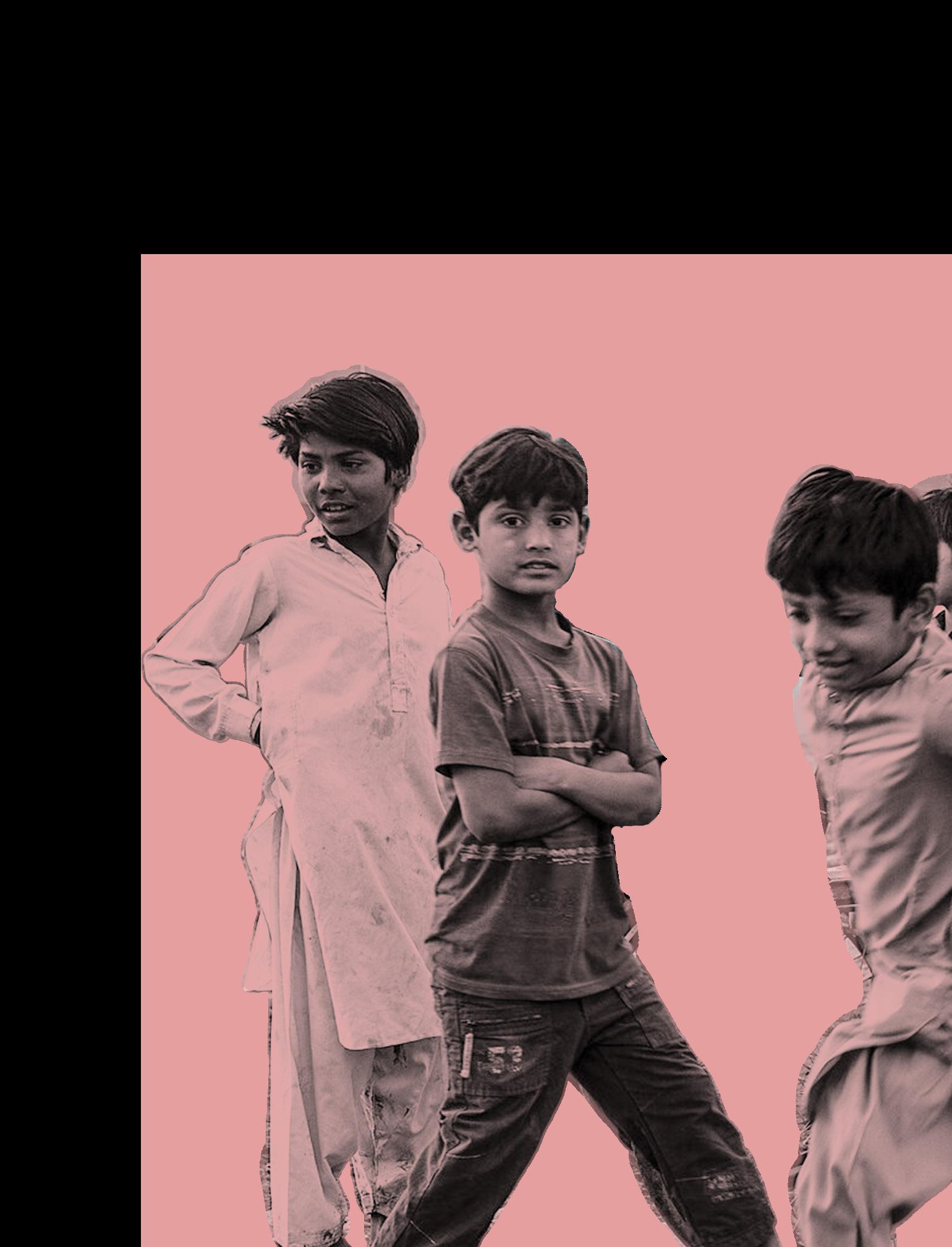
For education, a lack of infrastructure is clear and in some area’s, schools and mosques or churches are mostly merged into an educational center.
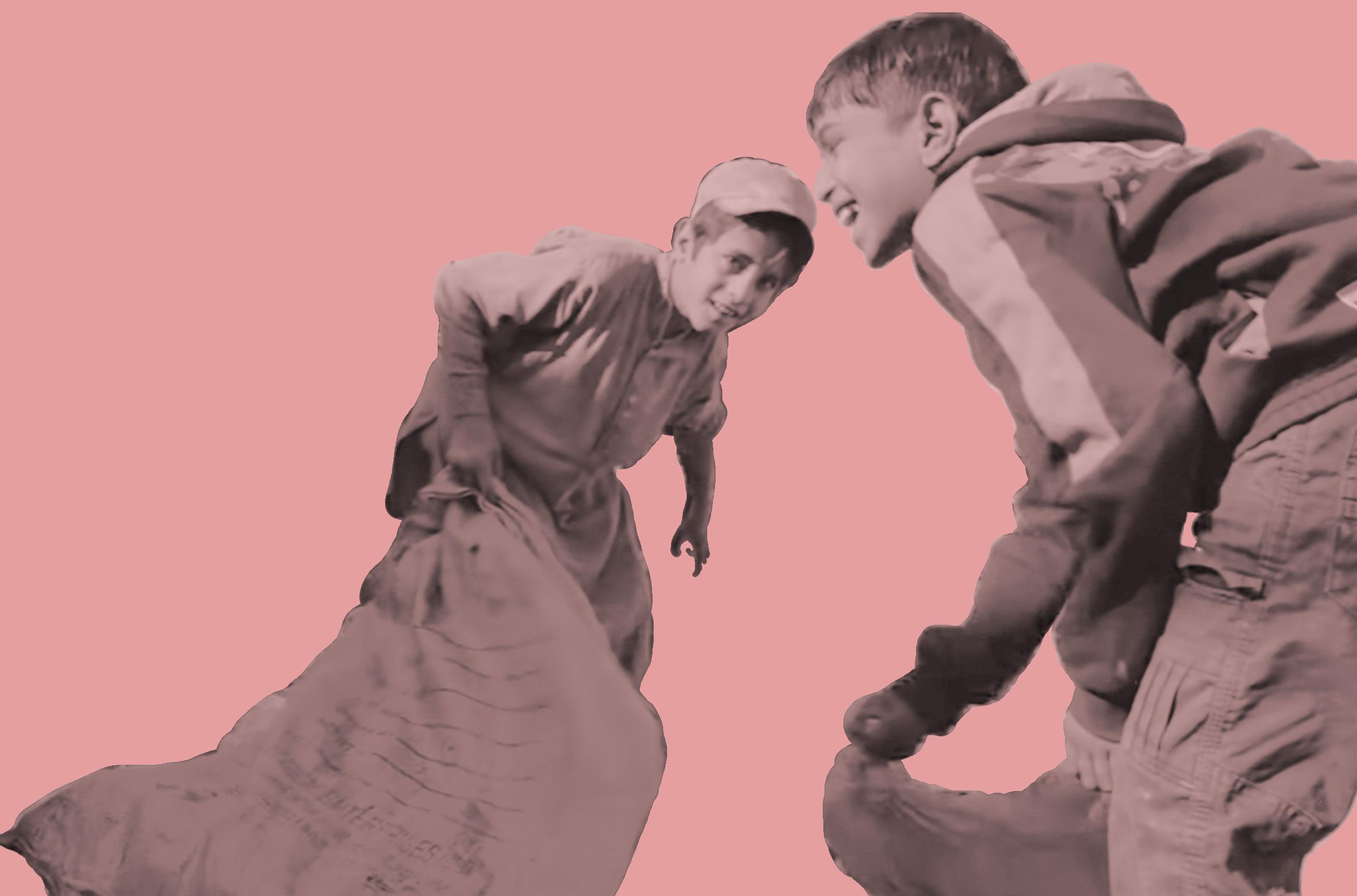

Absence of adequate education facilities and poor economic situation of the parents result in their children entering the labour at a young age. Most endeavours done by children on the Gujjar Nala are involved in picking up waste of recycling/Up-cycling or mechanical sevices.

Most economic endeavours on Gujjar Nala are small shops that are used for renting spaces for leisure.
Micro/Macro scale manufacturing facilities.
Recycling / Upcycling of waste material or textiles are a main source of income.
We have had very little documentation throughout the project, but we concluded that an entrepreneurial mindset was the way to design spaces that give the possibility to push forward their bussiness or services, aside than housing.

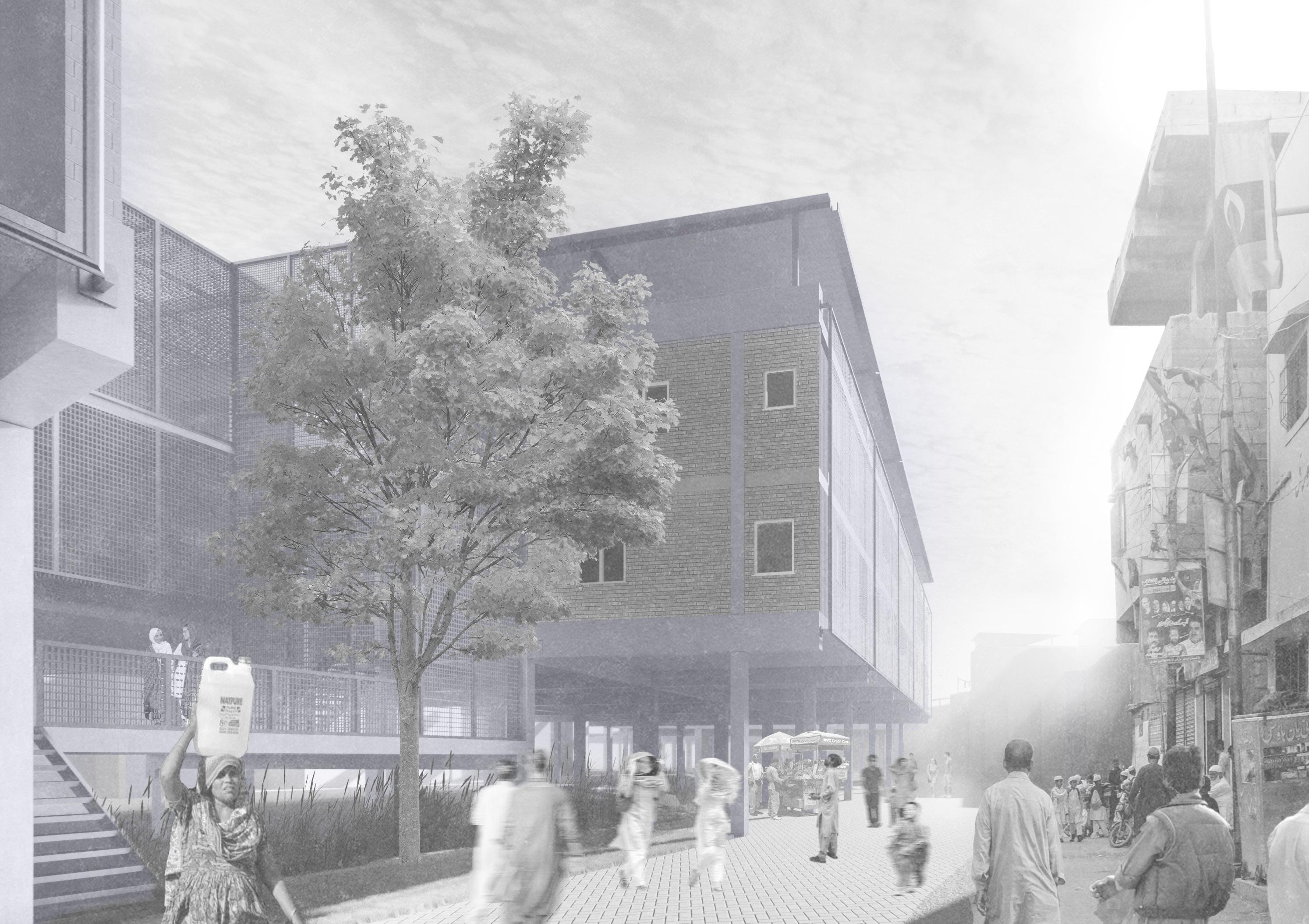

• NDMA (National Disaster Managment Authority)
Would be responsable for the free access to shared information, advise NGO’s and citizens to use their database as a direct source of information about possible exposition to floods.
• Sherhi-CBE
Would be responsable for the ecological and social activism around the project, visibilizing urgent ecological issues in the urban context and empower the citizens to take responsability into sustainable and resilient projects.
• OPP
Would be advisors and participant in the first Gujjar Nala pilot project, giving feedback and assess replicability and impact of the project with context based expertise.
• KUL (Karachi Urban Lab)
Would be responsable for the cooperation between Karachi urban planning entities and create relationships between architect and communities towards different translations of this pilot project to a city level project or global level project.
• West- & East riverside community
Would be responsable to chose a spokesman/leader/middleman that would participate to design and creation of the project.
• Spokesman
Would be responsable for bringing up the needs and desires of the community through conscensus and put forward to the communities the information and data needed for citizens to make informed descisions.
• Activist
Would be responsable for creating space for political discussions about the impact (positive or negative) of the pilot project and create a relation of power to force the attention of the government toward participative projects.
100m sample of Gujjar Nala

Our narrative implies that in order to break this loop shown before, sewage, solid waste and uncontrolled housing issues should be solved. Providing for resilient and climatic design housing infrastructure, will avoid that the dwellers ‘’ encroach the space” somewhere else. At the moment of flash floods, these sustainable housing design added to the nala widening, will ensure that this loop gets to a complete cut, but this is a situation that should be dealt with intellectual honesty en sensitivity.
Infrastructure Mismanagement
Sewage Solid Waste Uncontrolled Housing Relocation
Urban Floods
Migration of the informal communities

Our strategy implies bringing back the communities to their livelihood, but not to the same quality of life. We designed a raised housing structure that would minimize the footprint of the built area on the nala’s and leave free access for public life and work.
The housing structure follows the natural morphology of the nala adapting to the ongoing work of widening, and have a controlled evolution of the existing housing density, creating a new qualitative density, but significantly reduce the footprint of these communities on the nala it self. In fact, we designed spaces for facilities for them to work, produce and clean their living environment, creating what we called the Nala communities.

Connection to economic axis
We designed a building that translates the dumping of waste from the formal bridges to a solid waste manufacturing yard. All pedestrians are invited into the Gujjar Nala passing by a workforce of people who collect, recycle, upcycle and turn waste into salable items, such as bricks and with the remaining bio waste , compost would be reused for the regeneration of the nala biosphere.


We have designed a modular concrete structure that would work as a puzzle, to facilitate the replicability of the structure and provide clear instructions on how to build and how much materials would be needed.
The housings can be further developed at any time in the future until the desired end result is achieved. As we do not want to control but guide, The rules they have to follow are to be agreed from collaboration with NGO and CBO, who do have legal liability.
We designed a structure that will allow every unit to have a courtyard, and enable them to build up to 2 floors with a shaded roof space accessible for the residents.
Prefabricated puzzle framing
The average people per household in Gujjar nala is 9.
The capacity of this structure is for 2 households. Each person has 6.8 square meter ground area. So in total, 18 people can inhabit this structure.
We worked with materials that can be found locally such as metal grating floor, corrugated sheets, hollow core slabs and fog-catchers, a neo-vernacular way of catching water, which provides both shading and cooling. This way of working is implemented all over the project.
The total cost per person is 34.140 PKrupees (150 dollars).
The roof, made to protect the structures underneath from seasonal rains and for harvesting, is also a shading element, also for the space that aren’t build yet. Leaving spaces for the public activities.

We chose for a structure that would omptimize the polyvalency of the incremental housing needed troughout the years. The structure facilitates the use of constructions materials they are already used to work with.
All plots have the same area of 64 square meter yards. Each resident has the freedom to build any kind of house or room layout they wish. With the design, a guiding book would be provided in order to make informed descisions at the moment of building or incrementing their house.


Our understanding of their use of water made us conclude that water harvesting and filtering was needed in our design.

Grey water would go through a passive water filter made of plants, soil and active coal before taking its course in the nala again. That same water could be reused for daily shores and other not alimentary purposes.
The sewage is directly connected to the new housing structures and the roads beside the building will be made with bricks that will ensure soil permeability in case of rain and floods.
With the use of rainwater and fogcatchers, we make use of cheap and innovative ways to recuperate drinkable water, and free the communities from the time or money spend to get water on a daily basis.
We roughly calculated the amount of water consumed and produced on a autosufficient way after the project.



LOWEST DRINKABLE WATER/DAY
367m² X 4L = 1468 L
367m² X 9L = 3 303 L
HIGHEST DRINKABLE WATER/DAY
367m² X 15L = 5 505 L
Harvesting 100%
Harvesting 100%
Harvesting 100%
For 56,4 pers.(6unit)/day = 1468 L For 9,4 pers.(1unit)/day = 156 L
For 56,4 pers.(6unit)/day = 3 303 L For 9,4 pers.(1unit)/day = 550,5 L
For 56,4 pers.(6unit)/day = 5 505 L For 9,4 pers.(1unit)/day = 917 L
16 L/pers = 8% of daily usage/pers
58 L /pers
= 29% of daily usage/pers
98 L /pers = 49% of daily usage/pers


55m² X 146.3mm = 80 465L Rainwater
For 9.4 pers. per day for 1 year = 23,5 L
23,5 L/pers = 12% of daily water usage/pers



0.07 (US$)/m³ X 197m³ = 13.79 US$/pers (3 097,62 PkR)
COST/HOUSEHOLD = 129,62 US$/pers (29 116,28 PkR)
DAILY SAVINGS = 53,14 US$/pers (11 936,73 PkR)
YEARLY SAVINGS = 19 396 US$/pers (4 356 885,78 PkR)
We conclude that every household could save money and time from harvesting water. This free time serves for the social cohesion of the communities working around the main objectives of resiliency and autosufficiency.

The design of the semi private space or ‘street’ between the houses work as a ventilated corridor through the housing strctures. The metal grating floor provides a breeze from the nala in every direction. Also the use of brick jali screen provides privacy and ventilation to the courtyards.

We have inspired our housing units based on most-typical houses typology in Gujjar nala and have designed the same connection to the street as seen in this floorplan. The different connections are up to the decision of every house-owner but we have made the ‘street’ connected to the courtyard and further onto the other rooms.

Courtyards are generally 1/5 of the house and are used for leisure time but also for small businesses such as workshops, textile manufacturing, etc.


The kitchen is directly connected to the courtyard.

Main room is a polyvalent room that could be used for living/dining/sleeping, etc.
Mostly used by women as workspace during the day or for family gathering in the evening and as sleeping room at night. These main rooms are mostly connected to the courtyard.
Bedrooms are connected to mainroom and are used for sleeping and/or storing personal belonings.


The public space is designed to become a green space inviting to rest or walk along the quite shaded nala, we hope to create a spatial agency with the nala and understand the importance of regenerating and protecting the nalas, as an added value for their livelihood.
This spatial agency, would not only be enhanced by the replicability of the projects, but also with the amount of waste that would be taken out of the nalas.



The recycling yard are designed as such to receive the waste dumped by people from the formal bridge, as it used to happen in an uncontrolled way. We don’t want to control, but guide the process into innovative reuse of waste.
The design is simple, with materials commonly found on site, these are used to ensure the most polyvalent spaces possible in order for the community to organize the space as they want, although they can change the disposition of recycling materials, the different rooms are meant for the different purposes needed for the manufacturing of products, and the architecture, expresses that language.

The recycling yard would recieve waste picked-up by Karachi Metropolitan Corporation workers if needed, in adition to the waste produced by the Nala Communities, all pickers will work together towards cleaning the Gujjar Nala.
The amount and sort of waste will be clear later in the book but will be up to the community and NGO’s to discuss the possible production chain of manufacturing.

The recycling yard would also be open to receive waste from child garbage pickers present on site, they would pick up what we call, technological waste.
This waste could be reused or transformed in workshops together with other children, where they could learn to transform what they pick up and add value to the material they sell.

Small bags of construction waste would also be accepted at the recycling yard, these would be crushed and reused for future construction materials.
This construction materials could come from demolishions or other building waste from ongoing works in the neighbourhood. There is high production of construction materials as people constantly refurbish, increment or build houses and other structures.

Solid waste such as plastic, but also rests of biological waste will be picked up from the nala and sorted in the recycling yard for reuse or repurpose.
The intention is basically to create awareness on the added value that could be created from waste and how much economical and ecological advantages these new dynamics will have.













We want the citizens to be aware of the potential in their waste and reuse or repurpose it in innovative ways. The new spatial agency will make the nala communities thrive economically and enhance the ecological condition of the nala’s. Create an economical hub that would tackle the issue of waste landing in the nala and at the same time, manufacturing materials that could be used for their own spatial agency, the incrementality of their livelihood.

The materials able to be accepted in the recycling yard are mostly produced by household consumption or construction waste.
The collection of waste will be done by KM-workers, particulars and garbage pickers with all sorts of mobility tools.
Biological waste will be reused into compost or crushed for brick manufacturing if possible.
Glass and other sharp materials will be recycled into new materials or repurposed.
Construction materials coming from demolitions.
Plastics are sorted into 2 different groups, depending on their density.

Grinding the materials one by one and put them into a container ready to be mixed.
Upcyling of material will be done by local workers together with NGO’s and educational activities.
Mixing the materials in the right amount to make a paste.
That paste will then be poured into a mold that will give it the shape of any brick wanted.
The biological waste that could not be recycled or repurposed will be composted.

Drying the bricks will happen in less than 5 hours. these bricks will then be place on pallets.
The pallets produced will be used for other incremental projects.
The pallets produced will be sold.
The compost material will be used to plant greenery along the nala.
Once the waste is sorted in its respective containers, hard plastics and construction materials go through a crusher.
The crushed materials will go to a new container, from which a mixture will be made depending on the dimensions of the brick.

A mixture will be made from the technical waste and the construction materials added to water and cement if needed will make the paste that will be molded into bricks.

Economical activities using molds were present on site, although these men were pouring melted metals to shape objects, the molds and the sand are found to be commonly used on the site.
These molds are made by themselves and could take an important place in the manufacturing of the bricks.

The molds would be used to shape the mixtures of construction materials with others waste products.
These endeavours could be fullfilled by all the dwellers that can not go far from their home to work. This manufacturing chain could also be very practicle if some specific kind of bricks would be needed on site for an incremental house.

On either banks of the Gujjar Nala, many examples of usage of temporary coverings like fencing, fabric, asbestos sheets, and screens were seen to extend the living spaces of individual houses.
The resilient character of the locals and the connection of local community with the place makes possible the storage of many pallets of bricks.

In this brick manufacturing chain, we intend to design a space in which all the amount of waste produced by the communities could be transformed and from this strategy, reduce as much as possible the amount of waste ending up in the nalas.
Although this chain is the first one, we consider the designed spaces to be able to work together after replicability of this pilot project.



35% PLASTIC + 65% BINDING MATERIAL
Mass of crushed material in 1 Brick 0,15 kg
CONCLUSIVE RESEARCH :
If 100% of daily waste is manufactured 174 kg / 0,14 kg = 1243 bricks
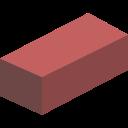

1 pallet = 765 bricks
1 pallet = 11,000 -14,000 PKR
25% BIO-WASTE + 75% BINDING MATERIAL
NO CONCLUSIVE RESEARCH :
We have studied the manufacture of Bio-waste bricks but need a controlled industrial process in order to get to a brick that could be used as a construction material, the lack of capability on site makes us conclude that an attempt could be made towards manufacturing bio-bricks, but we could not ensure it’s well-functioning.
The amount of bricks produced by recycling waste will considerably reduce the amount of waste ending up in the nalas.
If the daily waste is manufactured and sold, 20 persons will be provided with work and consistent salary.

Behind the manufacturing yard, a little platform design to reach the average height of the nala’s where floating objects could be taken out.
Once passed the recycling yard, bridges made out of the same materials used in the pilot project are designed to invite pedestrians to the nala promenade.


After replicability of this pilot project, we hope to create an evolving and growing community empowered by collaboration, resilience and innovative use of waste produced.
The Nala communities will have a new quality of life from which they do not only live for but work for.
‘The Guiding Book Towards A Nala Community’ is designed to give our technical insight on how to make the best use of the primary structure and clearly state the different possibilities of participation into the pilot projects for the respective actors.
We imagine a housing structure that brings the best of all stakeholders forward and show that multi-disciplinar and multi-scalar approaches can be based on the human perspective of a project.


8100m² demolished 1306 people evicted
Pilot project
574 m long 126 homes 9223m² (x2) >1176 people accommodated

150.000m² demolished 50.000 people evicted
Gujjar nala 28 km long 6146 homes 330.000 m² (x2) >57.365 people accommodated

Although we made the presentation of this project, suggesting a scenario in which 70% would be housing, as the statistics on ressetlement required, we still managed to design spaces for work, leisure and gathering.
We designed this project with a lot of good intentions, but got trapped in the amount of technicalities that such projects require. The physical distance between Brussels and Karachi added to the lack of data on the site we chose, made it very difficult to design with more senstivity for the existing situation. We have tried to make a feasable project in the context of Karachi, but designing for communties without being able to physically meet is almost impossible. The physical distance made us unaware that the conceptual descision of the project brought us further away from their practical need and desires.
Affordable housing is more than providing a house to a certain segment of the population. It’s about understanding the preferences of low-income groups, their social realities and how they navigate those realities. The term 'affordable housing’ merits a multi-dimensional understanding of the aspirations of low-income groups vis-à-vis housing. Urban planners need to have a holistic picture of the housing sector and connect it to existing methods of obtaining a house and services by low-income groups. There is great potential in the hands of these communities and it is up to us, Architects and urban planners, to create space for collaboration and mutual understanding.
https://climateknowledgeportal.worldbank.org/overview
https://www.preventionweb.net/news/pakistan-slum-dwellers-map-flood-risks-stop-evictions
https://floodresilience.net/blogs/how-community-mapping-of-storm-water-drains-is-fighting-evictions-in-karachis-informal-settlements/
https://climateknowledgeportal.worldbank.org/country/pakistan/vulnerability https://www.who.int/news-room/fact-sheets/detail/drowning
https://www.dawn.com/news/1447010
https://urckarachi.org/2021/01/29/filthy-rich-a-karachi-sewer-operation-for-a-sick-city/# http://cms.ndma.gov.pk/plans# http://cms.ndma.gov.pk/storage/app/public/plans/July2022/cUXRyPxhyUz3t5EiyTp5.pdf
https://karachibachaotehreek.org/update-on-gujjar-nullah-and-orangi-nullah-compensation-plan/ https://urckarachi.org/?s=gUJJAR+NALA
https://urckarachi.org/2021/09/17/the-displaced/ https://urckarachi.org/solid-waste/ https://urckarachi.org/2022/09/20/news-clippings-on-solid-waste-management-january-june-2021/ http://karachiurbanlab.com/publications.html
https://www.iied.org/how-community-mapping-storm-water-drains-fighting-evictions-karachis-informal-settlements https://www.dawn.com/news/1689141
https://www.samaaenglish.tv/news/2236984 -- GUJJAR Nalla demolition
https://urckarachi.org/2021/01/29/filthy-rich-a-karachi-sewer-operation-for-a-sick-city/# https://www.zameen.com/blog/brick-rate-pakistan.html
https://www.worldometers.info/co2-emissions/ https://www.thethirdpole.net/en/pollution/91-of-karachis-water-unfit-to-drink/ https://www.kazu.org/2018-09-10/for-karachis-water-mafia-stolen-h20-is-a-lucrative-business https://www.youtube.com/watch?v=Ur5eEoPv6j0
 By Maide Taslidere Levon Abrahamyan Alejandro Maturana With Asiya Sadiq Polack
By Maide Taslidere Levon Abrahamyan Alejandro Maturana With Asiya Sadiq Polack
